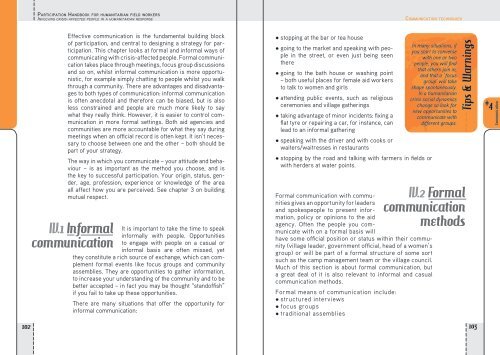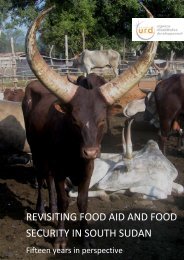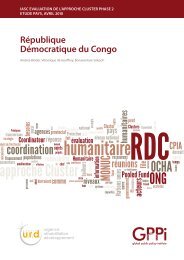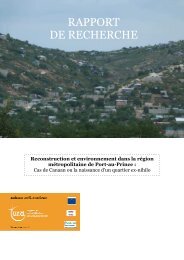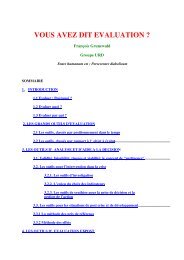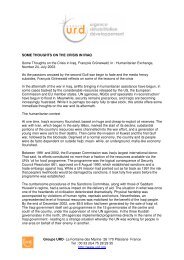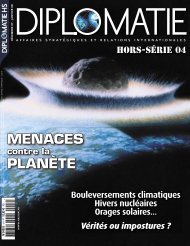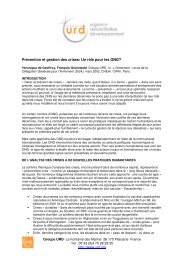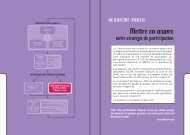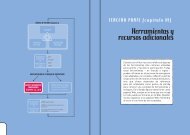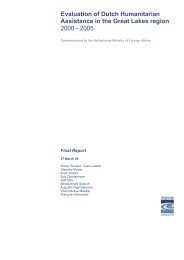Participation Ha n d b o o k fo r hu m a n i t a r i a n fi e l d wo r k e r sInv o l v i n g crisis-af f e c t e d pe o p l e in a hu m a n i t a r i a n re s p o n s eCo m m u n i c a t i o n te c h n i q u e s102Effective communication is the fundamental building blockof participation, and central to designing a strategy for participation.This chapter looks at formal and informal ways ofcommunicating with crisis-affected people. Formal communicationtakes place through meetings, focus group discussionsand so on, whilst informal communication is more opportunistic,for example simply chatting to people whilst you walkthrough a community. There are advantages and disadvantagesto both types of communication: informal communicationis often anecdotal and therefore can be biased, but is alsoless constrained and people are much more likely to saywhat they really think. However, it is easier to control communicationin more formal settings. Both aid agencies andcommunities are more accountable for what they say duringmeetings when an official record is often kept. It isn’t necessaryto choose between one and the other – both should bepart of your strategy.The way in which you communicate – your attitude and behaviour– is as important as the method you choose, and isthe key to successful participation. Your origin, status, gender,age, profession, experience or knowledge of the areaall affect how you are perceived. See chapter 3 on buildingmutual respect.IV.1 InformalcommunicationIt is important to take the time to speakinformally with people. Opportunitiesto engage with people on a casual orinformal basis are often missed, yetthey constitute a rich source of exchange, which can complementformal events like focus groups and communityassemblies. They are opportunities to gather information,to increase your understanding of the community and to bebetter accepted – in fact you may be thought “standoffish”if you fail to take up these opportunities.There are many situations that offer the opportunity forinformal communication:• stopping at the bar or tea house• going to the market and speaking with peoplein the street, or even just being seenthere• going to the bath house or washing point– both useful places for female aid workersto talk to women and girls• attending public events, such as religiousceremonies and village gatherings• taking advantage of minor incidents: fixing aflat tyre or repairing a car, for instance, canlead to an informal gathering• speaking with the driver and with cooks orwaiters/waitresses in restaurants• stopping by the road and talking with farmers in fields orwith herders at water points.Formal communication with communitiesgives an opportunity for leadersand spokespeople to present information,policy or opinions to the aidagency. Often the people you communicatewith on a formal basis willhave some official position or status within their community(village leader, government official, head of a women’sgroup) or will be part of a formal structure of some sortsuch as the camp management team or the village council.Much of this section is about formal communication, buta great deal of it is also relevant to informal and casualcommunication methods.Formal means of communication include:• structured interviews• focus groups• traditional assembliesIn many situations, ifyou start to conversewith one or twopeople, you will findthat others join in,and that a ‘focusgroup’ will takeshape spontaneously.In a humanitariancrisis social dynamicschange so look fornew opportunities tocommunicate withdifferent groups.Tips & WarningsIV.2 Formalcommunicationmethods103#4Communication
Participation Ha n d b o o k fo r hu m a n i t a r i a n fi e l d wo r k e r sInv o l v i n g crisis-af f e c t e d pe o p l e in a hu m a n i t a r i a n re s p o n s eCo m m u n i c a t i o n te c h n i q u e s104crises, new leadersmay emerge. Whendealing with formalrepresentatives ofa population, try tofind out how theygained their positionand the basis of theirauthority. Were theydemocratically electedor self-selected? Havethey discussed theissue at hand with thepeople they intend torepresent?Tips & WarningsIn humanitarian• organised discussions with targeted audiences likewomen’s groups and childrenYou can consider using many differenttypes of ‘meetings’ as part of your participationstrategy including focus groups,large assemblies and smaller meetings orinterviews. Whether formal or casual, allopportunities to exchange with people shouldbe taken seriously. They are a means of gaininginformation, developing understandingand building mutual respect and they allowpeople to both influence you and hold you toaccount.Planning meetings with groupsThere are already many resources for guidanceon facilitating meetings, running focusgroups and using techniques such as participatoryrural appraisal or participatorylearning in action. The aim of this handbook is not to repeatprior information, but to underline the main elements relevantto participation in humanitarian situations. Additionalresources can be found in Part 3.Although each meeting, interview, or event will differ interms of objectives and participants, a number of basicprinciples and general guidelines should be followed:Deciding on the purpose of the exerciseWhat do you want to achieve and how will you ensure realmutual communication between you and the people you talkto, rather than just extraction of information? In order todecide how you will communicate with different individualsand groups, it is useful to discuss this in advance with thoseconcerned.Gathering background informationIn order to prepare for a group session you will need tocollect some background information about the situationvia key informants, observation and informal discussion. Itis important to understand the security situation and thepotential risks to your team and theparticipants, to be aware of localsocial dynamics to avoid excludingor marginalising individuals orgroups of people and to be informedabout any political issues thatmight cast doubt on your independence,neutrality and impartiality.In humanitarian crises the situationcan change very quickly - be preparedto update your knowledge on aregular basis.In large, formal group sessionsindividual participation isdetermined by power relationswithin the group. Sociallymarginalized people such asethnic minorities, disabledpeople or women may notfeel they can contribute freely.By planning other smallerevents or meetings you canprovide these groups with anenvironment where they feelmore comfortable expressingthemselves.Planning events with the communityPreparation is important for agroup session such as a communityassembly. Knowing in advancewhat methods you are going to use,where the event will take place andwho the participants will be willhelp you to achieve your objectivesfor the meeting. Preparation caninclude a preliminary field visit toa possible venue and discussion ofthe purpose of the exercise, how it will be carried out andwho should attend.Ask some of your key contactsfor advice on how formal themeeting should be and anyother cultural tips. Dress andbehave as is necessary tobe taken seriously and showrespect to the participants.Keeping a recordWhatever your purpose or method, you are likely to want totake notes to help you remember what was said and to ensureaccuracy later on. It is important to explain why you are doingthis. Some people may be suspicious about what later usewill be made of the notes, especially if they are concernedabout their personal security. Avoid such worries by explaininghow the notes will be stored, and how you will ensureconfidentiality, for example, by not using real names or otherinformation that might be used to identify individuals.Their time…Time is a precious resource, especially when people are strugglingto survive. By informing people of what you are doing,Tips & WarningsTips105#4Communication


